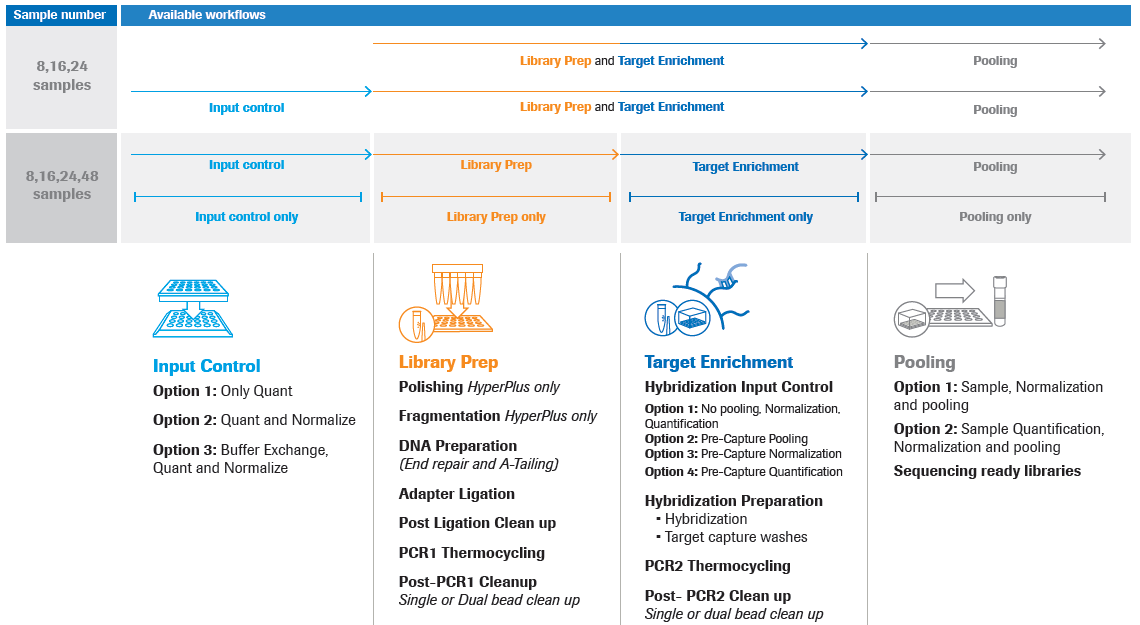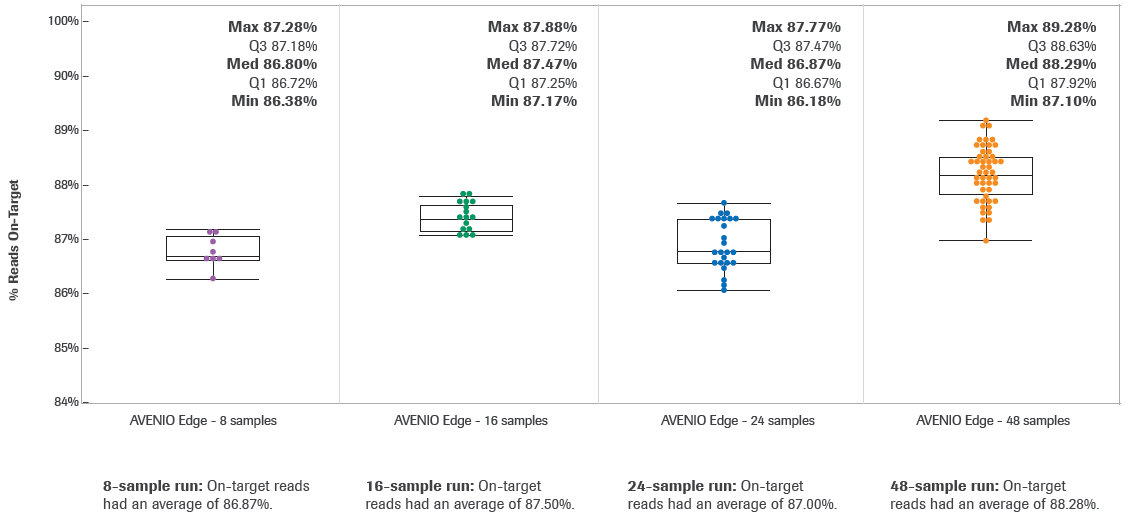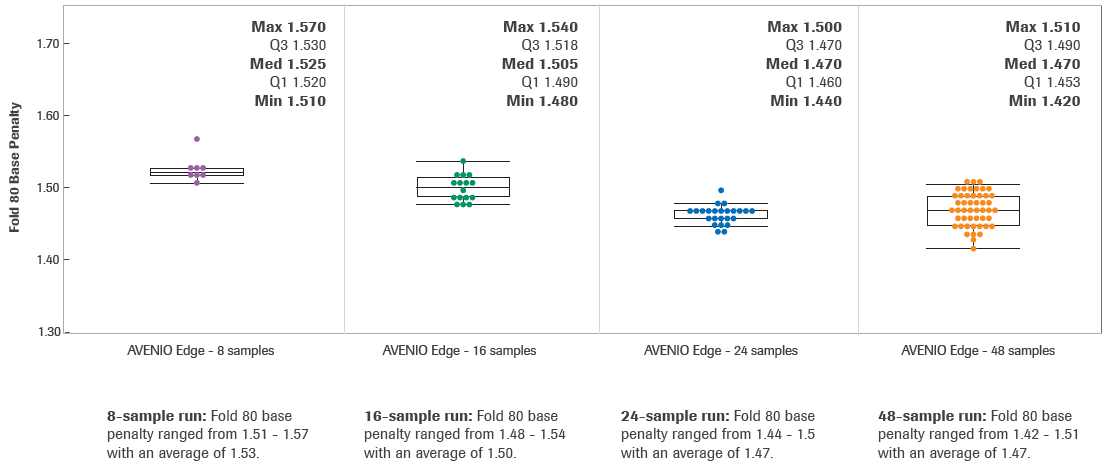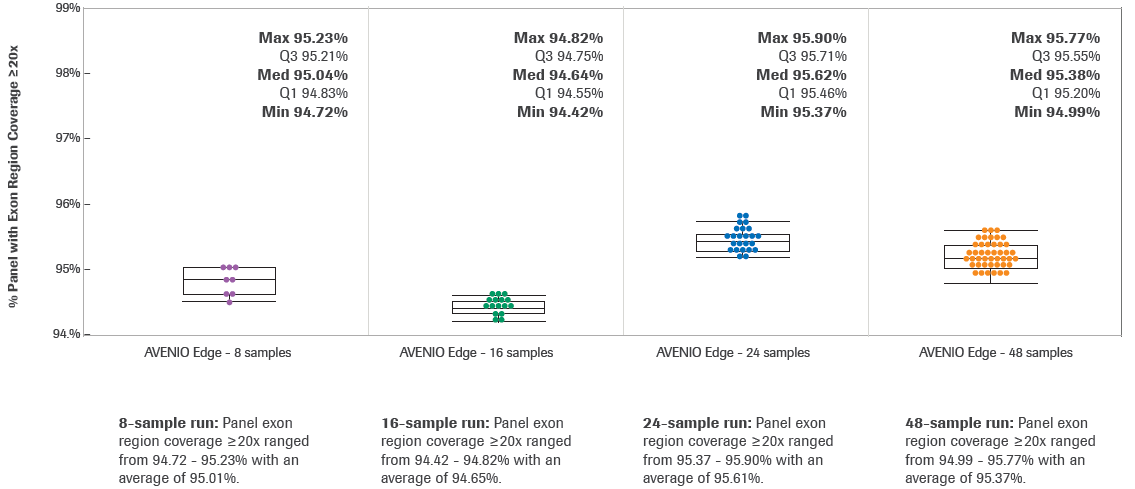Each year, the uptake and utilization of automation in the clinical laboratory is increasing at a rate of over 30%. This is rapidly advancing the development of new technologies and driving the early adoption of new next-generation sequencing (NGS) applications in the laboratory.
Automated systems offer a wide variety of benefits for the sequencing laboratory, such as:
- Better sample and workflow traceability
- Consistent and reproducible results
- Minimal hands-on time for higher staff productivity
- Reduced user error and sample contamination
- Rapid deployment of new workflows
The demand for clinical NGS is anticipated to grow by around 350% (~14% CAGR)1 over the next ten years, as hybrid capture-based methods are the preference for the majority of laboratories.
Roche can supply a wide variety of products to support both manual and automated hybrid capture workflows, such as the KAPA HyperExome Probes - Roche’s Whole Exome Sequencing solution.
The AVENIO Edge System is a completely automated solution for NGS library preparation, target enrichment, quantification and sample pooling.
This is supported by Roche’s award-winning KAPA library preparation portfolio, where users can experience results of the highest quality with total automation, integrated components, all thanks to verified protocols and end-to-end control.2
The AVENIO Edge System was developed to optimize resources, from staffing and labor to reagents and consumables, to overcome the majority of the barriers that laboratories face today. Moreover, the laboratory personnel are free to walk away from repetitive tasks and devote time to other important matters.
Simplified NGS sample prep workflows are achieved using the AVENIO Edge System due to:
- Efficient, consistent, high-quality results
- Hassle-free, ready-to-use reagents
- Intuitive system software for sample tracking and consumables inventory
- On-deck capabilities such as thermocycling and quantification
This article outlines the reliability and high-performance capabilities of KAPA HyperExome Probes on the automated AVENIO Edge System. Testing was performed across 287 samples of cell line DNA, with observations made on equivalent results for small (8 samples), medium (16 to 24 samples), and large (48 samples) batch sizes.
AVENIO Edge System offers extremely reproducible results
- Consistent post-capture library fragment size of ~323 bp
- Sample concordance regularly exceeds 96.8%
KAPA HyperExome Probes offers optimal performance on AVENIO Edge System
- High specificity with >86% (see Figure 4) of reads on-target
- High uniformity with Fold-80 base penalty as low as 1.4
Materials and methods
System and software
The AVENIO Edge System is a liquid handling robot that was developed for the purpose of performing input control, library preparation, pooling, target enrichment, and quantification in a single unit. The system outputs pools of libraries already prepared for sequencing.
The AVENIO Designer Software can be utilized for the generation of user-defined workflow templates offering the user the design flexibility to develop unique workflows with open parameters and run up to 48 samples in a single run.3
Input DNA
Cell line genomic DNA, NA12878, was acquired from Coriell Biocell Repositories. This Genome in a Bottle premium control extracted DNA stock was buffer exchanged before the study runs were performed on the AVENIO Edge System. Samples were prepared from 100 ng input following the product Instructions for Use.
Reagents
The AVENIO Edge DNA Hybridization User-defined Workflow (UDW) is made up of 9 reagent kit boxes. Roche sales representatives are able to offer detailed information regarding each kit box.
- Box 1: AVENIO Edge Quantification Kit
- Box 2: AVENIO Edge DNA HyperPlus Kit
- Box 3: AVENIO Edge Target Enrichment Kit, A
- Box 4: AVENIO Edge Target Enrichment Kit, B
- Box 5: AVENIO Edge Primer Plate A
- Box 6: AVENIO Edge HyperPure Beads
- Box 7: AVENIO Edge HyperPlex Adapter Kit
- Box 8: AVENIO Edge UDI Primer Mixes, 1-96
- Box 9: AVENIO Edge Solution A
The customer is supplied with four empty panel tubes, offering the flexibility to perform capture with their desired panel(s) for up to four panels in parallel captures per run. KAPA HyperExome Probes (43 Mb in capture target size), which are commercially available, were used for the duration of this study.
Workflow
The AVENIO Edge DNA Hybridization UDW offers 6 primary user-defined workflow templates: Input Control, LPTE 8/16S, LPTE 24S, LP 48S, TE 48S, and Post-Capture Pooling (as displayed in Figure 1).
These templates were converted to run protocols using the AVENIO Designer Software and uploaded onto the AVENIO Edge System.4 During these investigations, all six baseline workflow templates were tested, which included quantification, pre-capture and post-capture pooling of the DNA libraries on the instrument.

Figure 1. Diagram of AVENIO Edge DNA Hybridization User-defined Workflow (UDW) templates. Image Credit: Roche Sequencing and Life Science
Sequencing
Pools generated on the AVENIO Edge System were normalized by the system to 4 nM final molarity. Preparation of the pools for sequencing was completed using the NovaSeq™ 6000 System Denature and Dilute Libraries Guide.
Sequencing reagents were prepared per the guidelines, and the Illumina NovaSeq™ 6000 System was used for sequencing all libraries.
Analysis
For monitoring and determining the quality of the libraries being sequenced, the Illumina System Suite Version 2.2.0 was used. After the sequencing runs were completed, data analysis was conducted following the suggested pipeline in the white paper ‘How to evaluate Roche Target Enrichment data for germline variant research’.5
Results
The study included 4 test workflows with varying batch sizes (8, 16, 24 or 48 samples) per run (Table 1). Each of the workflows included AVENIO Edge User-defined templates for Input control, core Library Preparation and Target Enrichment (LPTE) template(s), and Post-capture pooling.
Every workflow followed the recommended baseline conditions for ≥40 Mb panels (capture target; see Appendix). Different strategies for pre-capture and post-capture pooling were tested, as outlined in Table 1.
Table 1. Description of test workflows. Source: Roche Sequencing and Life Science
| Run size |
Core LPTE template(s) used |
Pre-capture pooling strategy |
Post-capture pooling strategy |
| 8 samples |
LPTE 8/16S |
2-plex on-deck with 1500 ng target mass,
resulting in 4 pre-capture pools |
All pools combined on-deck into 1
output tube for sequencing |
| 16 samples |
LPTE 8/16S |
8-plex on-deck with *3000 ng target mass,
resulting in 2 pre-capture pools |
All pools combined on-deck into 1 output tube for sequencing |
| 24 samples |
LPTE 24S |
Singleplex |
All samples combined on-deck into
1 output tube for sequencing |
| 48 samples |
LP 48S and TE 48S |
Singleplex |
Combined on-deck into 2 pools of 24 samples each;
2 pools combined manually into 1 output tube for sequencing |
*A 3000 ng target mass has been internally validated at Roche for 8-plex pre-capture pooling strategies on the AVENIO Edge System
Sample quality metrics

Figure 2. Pre-Capture (PCR1) DNA Concentration (ng/uL). Image Credit: Roche Sequencing and Life Science

Figure 3. Post-Capture PCR DNA Concentrations (ng/uL). Image Credit: Roche Sequencing and Life Science
Sequencing metrics

Figure 4. The %Reads On-target (>86%) Demonstrate High Specificity. Image Credit: Roche Sequencing and Life Science

Figure 5. Median Insert Size (bp). Image Credit: Roche Sequencing and Life Science

Figure 6. The Low Fold-80 Base Penalty Values Demonstrate High Coverage Uniformity. Image Credit: Roche Sequencing and Life Science
Figure 7. % Panel with Exon Region Coverage ≥20x. Image Credit: Roche Sequencing and Life Science
Discussion
The objective of this study was to demonstrate the AVENIO Edge User-defined Workflow performance using the KAPA HyperExome Probes on the AVENIO Edge System for 8-, 16-, 24, and 48-sample runs. For this purpose, AVENIO Edge-specific reagents were used, which include quantification, library preparation, and target enrichment kits.
Validation of numerous user templates was completed for the system to span the various batch size requirement for various labs. The libraries generated showed compatibility with and ran on the Illumina NovaSeq™ 6000 System.
The KAPA HyperExome Probes were used in combination with the AVENIO Edge System and delivered high-performing target enriched libraries from 100 ng of a Coriell cell-line gDNA (NA12878).
Αs displayed in Figures 2-7, the AVENIO Edge System with the KAPA HyperExome Probes facilitates high-quality sequencing data with good specificity (% reads on-target) and outstanding uniformity (Fold-80 base penalty), irrespective of the run, pooling scheme (pre- or post-capture) or batch size used.
- Concordant high performance across various run templates
- Consistent post-capture library fragment size of ~323 bp*
- High specificity with % reads on-target greater than 86%
- High uniformity with Fold-80 base penalty as low as 1.4
*Data on file. The AVENIO Edge System is a Class 1 IVD and Class A CE IVDR and is intended for downstream diagnostic applications. Reagents and kits mentioned are for Research Use Only. They are not intended for diagnostic procedures. KAPA products are for Research Use Only. Not for use in diagnostic procedures.
Conclusions
The innovative AVENIO Edge System is a complete preanalytical platform that significantly reduces manual touchpoints and incorporates ready-to-load reagents, validated protocols, on-board capabilities, and intuitive software for effective and efficient management of NGS sample workflows.
The AVENIO Edge System offers superb performance and high-quality results while also offering:
- Efficient, consistent, high-quality results
- A full walk-away solution that boosts personnel’s productivity
- Hassle-free, ready-to-use reagents
- Intuitive system software for sample tracking and consumables inventory
- On-deck thermocycling and quantification capabilities
When used with the high-performing KAPA HyperExome Probes, the AVENIO Edge System prepares high-quality target enriched NGS libraries for uniform, efficient, reproducible whole-exome sequencing.
References
- Internal market research data
- AVENIO Edge System User Assistance v1.0 or later
- AVENIO Designer Software User Assistance, v1.0 or later
- AVENIO Edge User-Defined Workflow - DNA Hybridization Workflow Instructions for Use, v1.0 or later
- How to evaluate Roche target enrichment data for germline variant research - Roche White Paper (MC--08067)
About Roche Sequencing and Life Science
 Roche Sequencing & Life Science is part of Roche Diagnostics, which, along with Roche Pharmaceuticals, plays an important role in modern healthcare. Roche Diagnostics’ broad range of innovative diagnostic tests and systems play a pivotal role in the groundbreaking area of integrated healthcare solutions and cover the early detection, targeted screening, evaluation and monitoring of disease. Roche Diagnostics is active in all market segments, from scientific research and clinical laboratory systems to patient self-monitoring.
Roche Sequencing & Life Science is part of Roche Diagnostics, which, along with Roche Pharmaceuticals, plays an important role in modern healthcare. Roche Diagnostics’ broad range of innovative diagnostic tests and systems play a pivotal role in the groundbreaking area of integrated healthcare solutions and cover the early detection, targeted screening, evaluation and monitoring of disease. Roche Diagnostics is active in all market segments, from scientific research and clinical laboratory systems to patient self-monitoring.
Sponsored Content Policy: News-Medical.net publishes articles and related content that may be derived from sources where we have existing commercial relationships, provided such content adds value to the core editorial ethos of News-Medical.Net which is to educate and inform site visitors interested in medical research, science, medical devices and treatments.